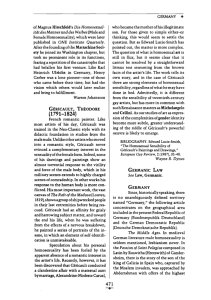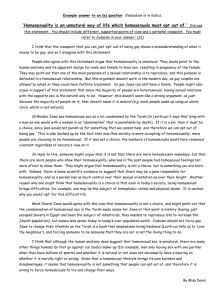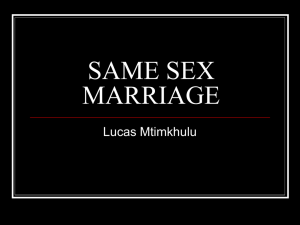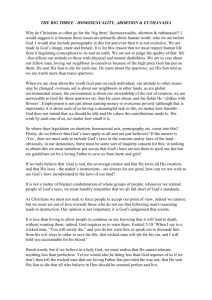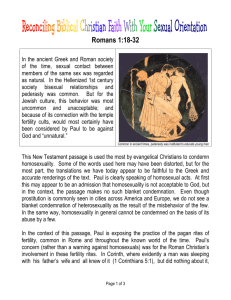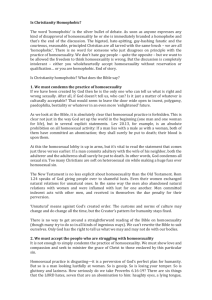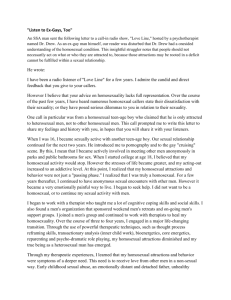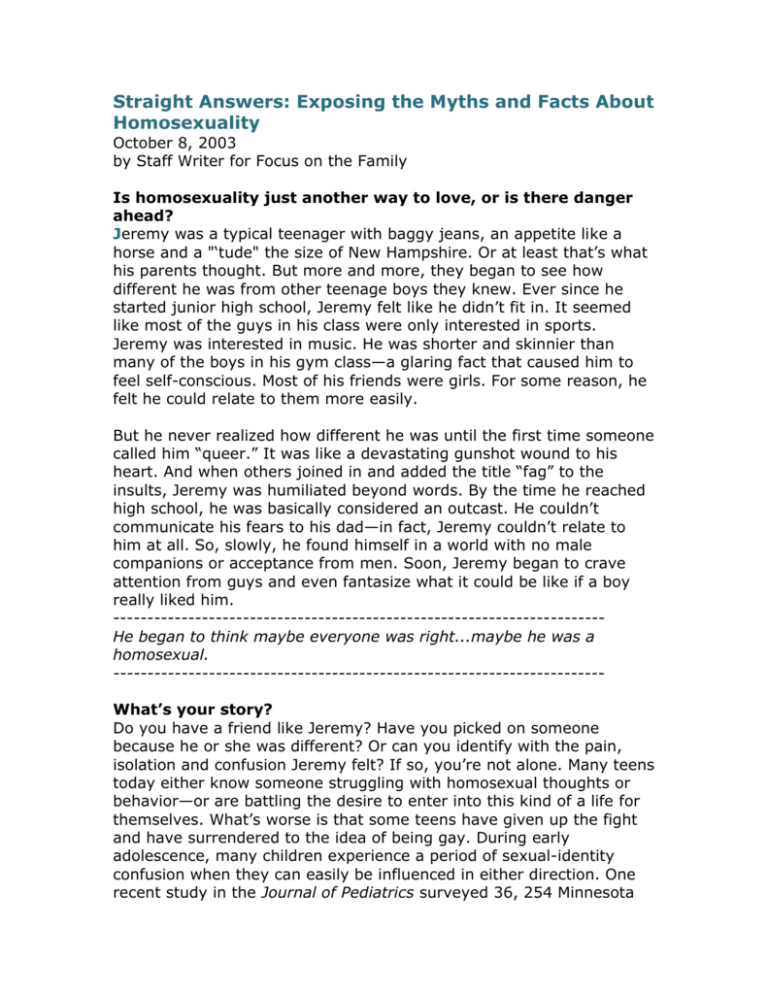
Straight Answers: Exposing the Myths and Facts About
Homosexuality
October 8, 2003
by Staff Writer for Focus on the Family
Is homosexuality just another way to love, or is there danger
ahead?
Jeremy was a typical teenager with baggy jeans, an appetite like a
horse and a "‘tude" the size of New Hampshire. Or at least that’s what
his parents thought. But more and more, they began to see how
different he was from other teenage boys they knew. Ever since he
started junior high school, Jeremy felt like he didn’t fit in. It seemed
like most of the guys in his class were only interested in sports.
Jeremy was interested in music. He was shorter and skinnier than
many of the boys in his gym class—a glaring fact that caused him to
feel self-conscious. Most of his friends were girls. For some reason, he
felt he could relate to them more easily.
But he never realized how different he was until the first time someone
called him “queer.” It was like a devastating gunshot wound to his
heart. And when others joined in and added the title “fag” to the
insults, Jeremy was humiliated beyond words. By the time he reached
high school, he was basically considered an outcast. He couldn’t
communicate his fears to his dad—in fact, Jeremy couldn’t relate to
him at all. So, slowly, he found himself in a world with no male
companions or acceptance from men. Soon, Jeremy began to crave
attention from guys and even fantasize what it could be like if a boy
really liked him.
-----------------------------------------------------------------------He began to think maybe everyone was right...maybe he was a
homosexual.
-----------------------------------------------------------------------What’s your story?
Do you have a friend like Jeremy? Have you picked on someone
because he or she was different? Or can you identify with the pain,
isolation and confusion Jeremy felt? If so, you’re not alone. Many teens
today either know someone struggling with homosexual thoughts or
behavior—or are battling the desire to enter into this kind of a life for
themselves. What’s worse is that some teens have given up the fight
and have surrendered to the idea of being gay. During early
adolescence, many children experience a period of sexual-identity
confusion when they can easily be influenced in either direction. One
recent study in the Journal of Pediatrics surveyed 36, 254 Minnesota
teenagers in the seventh to twelfth grades and found that 25.9 percent
of 12 year olds were uncertain about their sexual orientation; this
figure declines with age to five percent of 17-year-old students.1
If you think about it, who can blame them? Television glamorizes
homosexuality. Advertisements portray it as totally normal. Fashion
promotes androgynous styles, unisex clothing and even perfumes that
both men and women wear. Public schools teach that it’s OK. And our
government is mandating policies that promote things like tolerance
and “gay marriages.”
Hey, no wonder so many young people are struggling with their
sexual identity!
It seems like many teens today haven’t experienced how awesome it
is to be a guy or a girl. Have you? Do you realize your worth in God’s
eyes? We know from the Bible that every life is valuable because it is
made in the image of God. You are unique to Him (1 Corinthians 6:1920).
As Christians, we know that the sacredness of life is based on God’s
character—not our characteristics. We truly are not our own; we were
bought with a price. Knowing this, we should not be cruel to anyone
“different” from us . . . including homosexuals. We must respond to
them in love, just as Christ did. Yet, showing kindness, respect and
love for others doesn’t mean we have to affirm all that they do.
The world, however, will tell you a different story. Our era preaches
tolerance of all kinds and forms. In fact, it seems like mainstream
America believes tolerance is the ultimate virtue. But what exactly
does tolerance mean? One definition Webster offers for tolerance is “a
sympathy or indulgence for beliefs or practices differing from or
conflicting with one’s own.” So, if someone has beliefs or practices that
differ from ours-–or shall we say from God’s-- should we tolerate
them?
Christian professor and author Dr. J. Budziszewski has written much
on the issue of tolerance, and explains it as “the wisdom to know
which bad things to put up with, when, why and to what degree—
along with the strength of character to act on that wisdom.”2 And he
reminds young people that “it’s not necessarily intolerant to express
strong convictions if you do so with humility and gentleness.”3
Share the truth in love.
To share the truth, you have to care about the truth and about the
person with whom you’re sharing. If your care for that person isn’t
genuine and evident, chances are that the person will not hear what
you’re saying. The point is to share the truth in love—with compassion
and respect. And to share the truth, you’ve got to know the truth.
God, the Author of truth, has a few things to say about homosexual
behavior. For example, 1 Corinthians 6:9-11 (NIV) says, “Do you not
know that the wicked will not inherit the kingdom of God? Do not be
deceived: Neither the sexually immoral nor idolaters nor adulterers nor
male prostitutes nor homosexual offenders nor thieves nor the greedy
nor drunkards nor slanderers nor swindlers will inherit the kingdom of
God. And that is what some of you were. But you were washed, you
were sanctified, you were justified in the name of the Lord Jesus Christ
and by the Spirit of God.”
For more on what God has to say on this issue, check out these verses
in your Bible:
*
*
*
*
*
Leviticus 18:22
Romans 1:24-28
1 Timothy 1:8-11
2 Peter 2:6-10
Jude 7
In addition, you have to know the truth about homosexuality. There
are a number of myths regarding homosexuality that are making their
way to your ears. This article will help you debunk the myths and give
you the facts on the issues surrounding homosexuality so that you can
help someone you know (or even yourself) escape the dangerous web
of lies that can keep a person entangled in homosexuality.
MYTH #1: 10 PERCENT OF THE POPULATON IS HOMOSEXUAL
Don’t believe this lie. This myth took off when advocates began
misquoting a book written by Alfred Kinsey in the 1940s called Sexual
Behavior in the Human Male. Kinsey’s goal was to provide a scientific
look at human sexuality on the whole—homosexuality was just one
aspect of sexuality that he addressed. It’s very clear from more
sophisticated research methods that Alfred Kinsey’s 10 percent figure
is bogus.
FACT: ONLY 1 TO 3 PERCENT OF THE POPULATION COULD BE
CONSIDERED EXCLUSIVELY HOMOSEXUAL
4 Kinsey, who engaged in homosexual activity himself, never said ten
percent of the population was gay. He actually said: “10 percent of the
males are more or less exclusively homosexual for at least three years
between the ages of 16 and 55, but that only four percent were
exclusively homosexual throughout their lives, after the onset of
adolescence.”5 Kinsey’s research methods were also skewed by his
choice to include a high percentage of prison inmates and known sex
offenders, both of whom engage in homosexual behavior much more
frequently than individuals in the general population. 6 More recently,
a highly sophisticated study on sexuality in America, known as the
National Health and Social Life Survey (NHSLS), found that only 2.8
percent of the men and 1.4 percent of the women said they thought of
themselves as homosexual or bisexual.7
Homosexual activist groups now admit that the 10 percent myth is
false and that some have exploited the inflated Kinsey figures to try to
“create an impression of our numerousness.”8 In reality, the 10
percent figure is simply not true.
WHY DOES THE TRUTH MATTER?
Maybe you’re asking, “What’s the big deal?” Well, by saying that one
out of ten people in the U.S. is homosexual, some gay activists are
knowingly promoting a lie. They are declaring to the world that
homosexuality is “normal” and should be accepted as such. Yet, if you
think about it, this reasoning is unintelligent. For instance, 10 to 15
percent of Americans suffer from alcoholism, but we don’t accept this
behavior as normal or healthy. Even if 95 percent of the population
was addicted to alcohol, we still would not think of it as normal—or
acceptable.
As Christians we must ask ourselves, what standard will we live by?
Will we accept the so-called norms created by our society or seek God
and His Word to guide us in our lives? Sure, it’s tough to walk the
narrow way. But when we trust that God knows what’s best for our
lives—and follow His commands—we can receive His blessings and live
an abundant life . . . the life He intended us to live.
MYTH #2: HOMOSEXUALS ARE BORN GAY
Can someone be born a homosexual? In 1993, a respected research
journal, Science, published a study by Dean Hamer that ignited an
explosive “born gay” myth. Hamer basically claimed that science was
“on the verge of proving that homosexuality is innate, genetic and
therefore unchangeable—a normal variant of human nature.”9
The media went ballistic. National Public Radio, Newsweek, The Wall
Street Journal and several other news publications and programs
heralded stories that suggested scientists have discovered a “gay
gene.” Of course, in the fine print, reporters qualified statements
about this possible discovery because, in reality, there was no actual
discovery—but they did so in such a confusing manner! The public was
beginning to be persuaded.
Why is it so important for some homosexual activists to prove this
issue? Maybe the biggest possible reason is this: If the world was
convinced that some people are indeed born gay, then some would
feel there is a need to protect homosexuals by the government as a
designated minority class status, such as African- or Native-Americans.
Slowly but surely, it seems the government is embracing this view and
granting special rights to the homosexual community for what is a
behaviorally based identity rather than a true genetic one.
FACT: THERE IS NO EVIDENCE TO SUPPORT THE CLAIM THAT A
PERSON CAN BE BORN HOMOSEXUAL.
The scientific attempts to demonstrate that homosexual attraction is
biologically determined have failed. For example, a study conducted in
1991 by psychologist Michael Bailey and psychiatrist Richard Pillard,
attempted to show that homosexuality occurs more frequently among
identical twins than fraternal twins. However, this study actually
provides support for environmental factors versus genetics! If
homosexuality were in the genetic code, then both of the twins would
have been homosexual 100 percent of the time, yet this was not the
case.10
The well-known Simon LeVay brain study of 1991, which tried to find
differences in the hypothalamuses (a very small part of the brain) of
homosexual and heterosexual men, found no evidence that there is
any genetic cause for homosexuality. Nothing in the study showed that
gay men are born that way.11 Other prominent researchers have
concluded that there is no evidence to support a biological theory, but
rather that homosexuality could be best explained by an alternative
model where “temperamental and personality traits interact with the
familial and social milieu as the individual’s sexuality emerges.”12
WHY DOES THE TRUTH MATTER?
As the myth of being born gay is more accepted by our society and
government, our country is seeing the effects. For instance,
increasingly more states are trying to legalize same-sex marriages.
Educational curricula now include courses on lesbian, gay, bisexual and
transgender studies.13 Clearly, our perception of science can affect
political policies. LeVay, the researcher and gay activist mentioned
previously, made an interesting observation about the emphasis on
the biology of homosexuality. He noted, “…people who think that gays
and lesbians are born that way are also more likely to support gay
rights.”14
Let’s face it: science is meant to be fact . . . not theory. So, when the
media takes hold of false theories of genetic links to homosexuality
and promotes it as science, people are led astray. This is not right.
Even if somewhere in the future a genetic link could be proven, it
wouldn’t suddenly make the behavior right—or acceptable to God.
Look at alcoholism or tendencies toward anger. While these have been
promoted as having a genetic linkage, there are few, if any, in our
society who would accept such behaviors just because they are linked
genetically. God’s Word still makes no provision for any type of sexual
activity except that found within heterosexual marriage between one
man and one woman. So to answer the question, “Are homosexual
attractions biological?” the conclusive answer is there is no support in
the scientific research for the conclusion that homosexuality is
biologically determined.
MYTH #3: HOMOSEXUAL RELATIONSHIPS ARE NO DIFFERENT
THAN HETEROSEXUAL ONES
Homosexual advocates want their relationships to be treated the same
as heterosexual ones. But are homosexual relationships any different
than heterosexual ones? You’d be surprised.
FACT: HOMOSEXUAL MALE RELATIONSHIPS ARE RARELY
MONOGAMOUS AND THOSE INVOLVED ARE MORE AT RISK FOR
LIFE-THREATENING ILLNESSES
Studies indicate that the average male homosexual has hundreds of
sex partners in his lifetime. The median number of partners for
homosexuals is four times higher than for heterosexuals.15 A study on
the sexual profiles of 2,583 older homosexuals, published in the
Journal of Sex Research, found that only 2.7 percent claimed to have
had sex with one partner only.16 Research has also found that few
homosexual relationships last longer than two years, with many men
reporting hundreds of lifetime partners.”17
Check out these findings:
*
*
*
24 percent of gay men had over 100 partners
43 percent of gay men had over 500 partners
28 percent of gay men had over 1000 partners18
Solid, irrefutable evidence proves that there are lethal consequences
to engaging in the defining features of male homosexuality—that is,
promiscuity. Active homosexuals are vulnerable to dozens of sexually
transmitted diseases.19 According to one report, the risk of anal
cancer rises by an astounding 4,000 percent for those engaging in
homosexual intercourse and doubles again for those who are HIV
positive.20
AIDS remains the fifth leading cause of death among those aged 26 to
44, and 60 percent of new cases are contracted by men who have sex
with men.21 Despite the twenty-year “safe-sex” campaign, the
incidence of unsafe sexual practices resulting in various diseases is on
the rise.22 An estimated 30 percent of all 20-year-old homosexual
men will be HIV positive or dead by the age of 30.23
Studies have also found that while homosexuals may be trying to
convince themselves that what they are doing is acceptable, they have
serious doubts in their hearts. A Columbia University study on
“internalized homophobia” among homosexual persons found that a
significant percentage of homosexuals surveyed held negative
attitudes toward their own homosexuality and toward other
homosexuals.24
While there are some who would promote the myth that homosexual
relationships are no different than heterosexual ones as pure fact,
there are also those from the gay community who admit it to be a
false statement. Andrew Sullivan, a prominent conservative gay
author, says that gay couples adhere to a very different moral
standard than straight couples do. He says their moral standard is one
in which “a greater understanding of the need for extramarital outlets”
exists.25 Also, two researchers who professed themselves to be a gay
couple came to the conclusion that gay relationships between men
rarely survive if they are not open to outside sexual contacts.26
WHY DOES THE TRUTH MATTER?
God created the unique relationship between a man and a woman. Yet
He is equally unhappy with pre-marital sexual relationships as He is
with homosexual relationships. Both are not what He intended. To say
that homosexual relationships are the same as heterosexual ones is to
make a mockery of God’s divine act of creation and His ordination of
marriage. He made man and woman for each other and called it
“good” (Genesis 1:26-28,31). To say otherwise is to lead people
astray.
MYTH #4: AIDS IS AS MUCH OF A RISK FOR HETEROSEXUALS
AS IT IS FOR HOMOSEXUALS
Of course, AIDS is a risk for anyone who engages in sex—especially if
that someone is “not a virgin, or who is, or was, an intravenous drug
user or blood product recipient.”27 But we’ve already established that,
in general, homosexuals are more promiscuous than heterosexuals.
Therefore, it is likely that homosexual men are at a greater risk than
heterosexuals for contracting AIDS.
FACT: ACCORDING TO THE CENTERS FOR DISEASE CONTROL,
HOMOSEXUAL MEN ARE A THOUSAND TIMES MORE LIKELY TO
CONTRACT AIDS THAN THE GENERAL MALE HETEROSEXUAL
POPULATION.28
Whoa! While AIDS has indeed become a universal disease, (and you
are still at risk when you engage in pre-marital heterosexual behavior)
it is an undeniable fact that the potential for an individual to become
infected is much more pronounced for homosexual men.
Studies have indicated that the body’s natural immune system is
broken down by repeated exposure to semen during anal intercourse.
Also, the tearing and rupturing which can take place during such
intercourse exposes the individual to infection by manifold serious and
dangerous diseases. Of these, AIDS is the most well-known and the
most dangerous.29 AIDS remains within the top 10 leading causes of
death among those aged 20 to 55. As of December, 2001, 45 percent
of all AIDS cases involved men who were exposed to the disease
through having sex with other men while 4 percent of the cases were
among men who had heterosexual contact.30
WHY DOES THE TRUTH MATTER?
There is a great physical danger in circulating the myth that
homosexuals are not at a greater risk for contracting AIDS than
heterosexuals. Of course, there are other risks for those who are
involved in homosexuality: isolation, heartache, confusion,
disillusionment, abandonment, etc. When you’re living outside of God’s
will for your life—whether by experimenting with homosexuality or
willfully embracing any other sin—you will feel the effects one way or
another. And probably the biggest result of living a sinful life is not
having peace with God.
MYTH #5: HOMOSEXUALS ARE NORMAL, HEALTHY, EVERDAY
PEOPLE
While the American culture promotes “having it all,” it is likely that
most individuals just want to be accepted and appreciated.
Homosexuals are no different. They have been wounded by rejection
and, in general, seem to say whatever it takes to be considered
“normal.” Ironically though, society’s intolerance doesn’t seem to be
what’s driving homosexuals into more risky and dangerous behavior.
In fact, such conduct tends to exist most intensely in places where
homosexuals face the least amount of disapproval—such as large cities
like New York and San Francisco or on college campuses with
concentrated gay communities.
FACT: CONTRARY TO CLAIMS MADE BY GAY ACTIVISTS,
HOMOSEXUALLY ACTIVE PERSONS AS A GROUP APPEAR TO BE
LESS PSYCHOLOGICALLY HEALTHY THAN THE GENERAL
POPULATION
There are several areas where the average homosexual differs from
the average, normal, "everyday” heterosexual. Research has shown
that men and women living homosexually are at substantially higher
risk for some forms of emotional problems, including suicidality, major
depression and anxiety disorder, conduct disorder and nicotine
dependence.31 For instance, one twin-study found that men with
same-sex partners are 6.5 times as likely as their co-twins to attempt
suicide.32 Another study found that a substantial percentage of gay
males and lesbians report some participation in illegal drug use.33
WHY DOES THE TRUTH MATTER?
Paul states in the book of Romans that homosexuality is “unnatural.”
But some homosexuals will tell you they’ve been attracted to people of
the same sex for as long as they can remember—in other words, it
just feels natural to them. Unfortunately, their feelings do not justify
their actions. “Sin” is any behavior that is displeasing to God. We live
in a fallen world and sin has distorted our perception of truth—so,
what someone may consider as natural or normal still cannot change
the truth of God’s moral laws found in the Bible.
Homosexuality is only one symptom of fallen humanity. In our
brokenness of human nature, we have an undeniable inner craving to
be whole. And yet, maybe it’s because of our sinful nature that we
(homosexuals and heterosexuals) seek wholeness in the wrong areas.
Whether we’re struggling with same-sex attractions, pornography,
envy or lying, it’s easy to want to slap a label of “normal” or “healthy”
on ourselves to try to justify our sinful behaviors. But a label will never
cover the deep wounds of people entangled in a life that is displeasing
to God. The only place a person can find healing and wholeness is at
the foot of the cross.
MYTH #6: THE BIBLE DOESN’T CONDEMN HOMOSEXUALITY—
ONLY PROMISCUITY
In recent years, several mainline denominations have abandoned
traditional interpretations of Scripture and have embraced the "GayChristian" movement. Similarly, people claim that Paul’s statements
were only addressed to believers back then and are not relevant
today. But God’s Word—which is unchanging and stands forever
(Isaiah 40:8) gives us a different story.
FACT: GOD CLEARLY CONDEMNS ANY ACT OF SEX OUTSIDE OF
HETEROSEXUAL MARRIAGE
God designed sexual relationships only for a union between one man
and one woman in marriage. The first chapter of Genesis declares that
“God created man in His own image . . . male and female He created
them.” Throughout this chapter we learn why fornication, adultery and
prostitution—as well as “homosexual marriage”—are all distortions of
God’s original plan for healthy sexuality.
In the Old Testament, the sin of homosexuality is condemned by the
Law of Moses (Leviticus 18:22). In Matthew, male and female
relationships are the only sexual relationships allowed by Jesus
(Matthew 19:4-6). And the first chapter of Romans is usually
considered the most thorough and clear condemnation of
homosexuality in the Bible, which includes a specific reference to
lesbianism (Romans 1:24-27).
WHY DOES THE TRUTH MATTER?
There are many distortions in sexuality because of the effects of sin,
which have caused grief and hardship to so many. We know from the
Bible that those who practice homosexual acts receive “in themselves
the due penalty for their perversion” (Romans 1:27, NIV). As the
executive director of Exodus International—North America, the world’s
leading outreach to those affected by unwanted homosexuality, Alan
Chambers sees the devastation that occurs when the lines between
right and wrong are blurred, erased or reversed. He states: “Today,
culture is moving further and further away from biblical teachings
about sexuality and gender. We now have an entire generation of
young people being taught that homosexuality is morally, physically
and spiritually equivalent to heterosexuality. Because of the downward
spiral that has become our way of life, it is not surprising that people
are questioning what is right and wrong regarding sex when wrong is
now considered normal.
-----------------------------------------------------------------------Our actions--good and bad--have consequences that impact us, our
society and every single living person that comes after us until
eternity. The truth matters because it means freedom for all who
believe it and abide by it.
-----------------------------------------------------------------------While God’s Word is clear on the matter of homosexuality, it’s also
very clear on the matter of healthy sexuality. You’ve probably heard it
said that “God has a plan for your life.” Would you believe He also has
a plan for your sexuality? He does! He planned for us to have an
exciting love life in marriage.
MYTH #7: LESBIAN RELATIONSHIPS ARE HEALTHIER THAN
GAY MALE RELATIONSHIPS
It’s generally believed that women who have sex with women are less
likely to contract a sexually transmitted disease than gay men. While
most of the research on medically related health risks of homosexual
activity deals with men who have sex with other men, there is
interesting research concerning homosexual activity among women.
FACT: LESBIAN RELATIONSHIPS ARE EQUALLY UNHEALTHY,
AND JUST AS LIFE-THREATENING AS GAY MALE
RELATIONSHIPS
The fact is, most women who have sex with women do not do so
exclusively. Approximately two-thirds of women surveyed have also
had sex with men within the last five years.34 Sexually transmitted
disease rates for bisexually active women are as much as twice that of
those who engage in exclusively lesbian activity. 35 Likewise, studies
have also shown that a significant number of lesbian women engage in
other risky behaviors which increase medical risks of disease, such as
drug use and exchanging sex for drugs and money.36 Another study
reported that lesbians may have higher rates of breast and ovarian
cancer because of a variety of risk factors like nulliparity (never having
borne a child), childbearing later in life, higher rates of alcohol
consumption and obesity.”37
The National Coalition of Anti-Violence Programs (NCAVP) has reported
that domestic violence is as common in lesbian, gay, bisexual and
transgender relationships as it is in heterosexual relationships. While
Lesbian partnerships generally are of longer duration than gay male
relationships, there exists the counterfeit of healthy attachmentincluding, manipulative behaviors, emotional dependency and overenmeshment.38
WHY DOES THE TRUTH MATTER?
It’s important that women know the consequences of their choices.
Lesbians are not excluded from the realities of promiscuity, like the
HIV virus. The sad truth is that because this myth is being
perpetuated, many lesbians are going to the doctor less often. While
most heterosexual women visit the gynecologist every eight to nine
months on average, the average for lesbians is every 21 to 24
months.39 This is cause for great concern as “many lesbian-identified
women have other risk factors for cervical dysplasia, such as multiple
male partners, heterosexual intercourse at an early age and cigarette
smoking.”40
Again, God’s Word clearly speaks of consequences to sinful behavior.
The only true form of “safe sex” is abstinence, or within a heterosexual
marriage of one man and one woman. Whether you have lustful
temptations for someone of your same sex or of the opposite sex, you
can take a stand for purity and experience a lifetime of rewards. True
love is worth the wait—not only because the risk of promiscuity, but
because God has only blessed sex in the context of a heterosexual
marriage.
MYTH #8: HOMOSEXUALITY IS UNCHANGEABLE
This is probably the most devastating myth of homosexuality
circulating today. Yet, most homosexuals believe that their
homosexuality is so much a part of their identity, that they can do
nothing about it. In his report, “Homosexuality in America: Exposing
the Myths,” Richard Howe suggests two major reasons why
homosexual activists promote this myth:
1. They would be admitting that there are those in the homosexual
community who, after careful thought, have concluded that it is wrong
to be homosexual and that it does not lead to personal happiness and
fulfillment. Focusing on those homosexuals who want to change
continues to emphasize the immorality and personal destructiveness of
homosexuality.
2. They would be denying that homosexuality is physically caused. The
more the homosexual community can convince the general public that
their homosexuality is beyond their control, the more tolerance or
even preferential treatment they can gain in public policy.41
FACT: THERE IS FREEDOM FROM HOMOSEXUALITY
The truth is, there are a tremendous number of homosexuals who
have changed, and professional opinions are changing on this issue as
well.
Dr. Robert L. Spitzer, the prominent psychiatrist who led the team that
deleted homosexuality from the diagnostic manual in 1973, now says
homosexuality may be changeable. “Like most psychiatrists,” said Dr.
Spitzer, “I thought that homosexual behavior could be resisted—but
that no one could really change their sexual orientation. I now believe
that’s untrue—some people can and do change.” 42 To the
researcher’s surprise, good heterosexual functioning was reportedly
achieved by 67 percent of men who had rarely or never felt any
opposite-sex attraction before the change process.43 “Contrary to
conventional wisdom,” Spitzer concluded, “some highly motivated
individuals, using a variety of change efforts, can make substantial
change in multiple indicators of sexual orientation and achieve good
heterosexual functioning. I’m convinced from the people I have
interviewed, that for many of them, they have made substantial
changes toward becoming heterosexual . . . I think that’s news . . . I
came to this study skeptical, I now claim that these changes can be
sustained.”44 Other professionals have reported a range from 50 to 70
percent success rate in the treatment of unwanted homosexual
attraction.45 Findings such as these have prompted some
professionals to admit that homosexuals can change their sexual
orientation through a variety of change efforts.
Individuals who have gone through an Exodus International Member
Ministry have discovered that Jesus Christ is sufficient to make the
difference. “The road begins not with just giving up on the gay life, not
with trying to relate with a woman, not with just trying to relate to
other men in a different way; it begins with coming into a relationship
with God . . . From where many of us stand who have gone down that
road, it was difficult, but it was worth it a hundred times over, because
it has been the way to joy, freedom and personal fulfillment.”46 Is
homosexuality unchangeable? Hardly. There is plenty of evidence that
homosexual attraction can be diminished and that changes can be
made.
WHY DOES THE TRUTH MATTER?
God is clear about the consequences of unrighteousness such as
homosexual behavior. Yet, as with other sinful lifestyles,
homosexuality is forgivable if a person repents of his or her actions
and turns to God. His power can bring healing, restoration and change.
That’s the message that’s being silenced today: there is freedom from
homosexuality through the unconditional love and grace of Jesus
Christ. Of course, ending a destructive behavior—especially one that is
addictive in nature like drinking, smoking or having homosexual (or
heterosexual) intercourse—is a difficult task. But there is so much
hope with Jesus! Think about it: God’s power is amazing! If He could
raise Jesus from the dead, He can rescue a person from any
entanglement.
If we confess our sins, he is faithful and just and will forgive us
our sins and purify us from all unrighteousness.
-1 John 1:9, NIV
Therefore, if anyone is in Christ, he is a new creation; the old
has gone, and the new has come!
-2 Corinthians 5:17, NIV
YOU CAN HELP SOMEONE STRUGGLING WITH HOMOSEXUALITY
The best thing you can do for someone you know battling the sin of
homosexuality is pray! Ask God to give you opportunities to show your
care and concern for them and pray for the strength and courage to
share the truth in love. Dr. Jeffrey Satinover has written extensively
on the struggle of homosexuality and has helped countless people help
others—and help themselves. The following has been adapted from his
“What to Do . . . and Not to Do” list from his report Homosexuality
Facts versus Fictions.47
1. Remember that all of us have sinned and fallen short of God’s glory.
So, be willing to share about your own personal struggles and
temptations.
2. Don’t condemn. People have not “chosen” to “have homosexual
feelings” the way some choose to live in a certain city. To describe it
this way is to convince them that you have no understanding at all
about their experience—and no sympathy for it, as well. Know that the
core of the homosexual struggle is rejection.
3. Don’t start citing all the problems with homosexuality. Consider how
rarely exhortations convince someone to give up alcohol or smoking.
But don’t go to the opposite extreme either. Unquestioning acceptance
of homosexuality as a legitimate “alternative” may seem at first to be
the only compassionate option. But there are better and more
appropriate approaches that show concern and understanding, yet
deal with the reality of the situation.
4. Try to prevent the problem before it occurs. Openly discuss the
subject of homosexuality with your friends or anyone you are close to
who may be struggling. Familiarize yourself with the causes and
address them at an early time. Help them understand the risks.
5. Share specific avenues of help like the ministry of Exodus
International–North America that has helped thousands of men and
women in the midst of their struggle with homosexuality. Give them
hope that change is possible! Perhaps even share this article with
them. Even if the person is defensive and resistant, a specific route of
assistance that is lovingly offered may be followed some day down the
road.
6. Show love, concern, gentleness and respect as you point the way to
healing.
Need more help?
Exodus International-North America is a worldwide coalition of
Christian ministries that offers support to men and women seeking to
overcome homosexuality, as well as services for family members and
friends. Most of these ministries offer support groups, one-on-one
counseling and literature. For a free packet of literature on the work of
Exodus, including a complete list of referral ministries, contact: Exodus
International-North America, P.O. Box 540119 Orlando, FL 32854;
(888) 264-0877; e-mail: info@exodus-international.org;
www.exodus-international.org.
-----------------------------------------------------------------------1 G. Remafedi, M. Resnick, R. Blum, and L. Harris, “Demography of Sexual
Orientation in Adolescents” The Journal of Pediatrics, vol. 89, no. 4, April 1992, pp.
714-21.
2 J. Budziszewski, Ph.D., “A War of Words,” Boundless, www.boundless.org,
September 30, 1998.
3 Ibid.
4Sex in America: A Definitive Survey, Robert T. Michael, John H.Gagnon, Edward O.
Laumann, and Gina Kolata, Little, Brown and Company, Boston, 1994, p. 176.
5Sexual Behavior in the Human Male, Alfred C. Kinsey, Wardell B. Pomeroy, Clyde E.
Martin, W.B. Saunders Company, Philadelphia and London, 1948, pp. 650-651.
6Kinsey, Sex and Fraud, Judith A. Reisman, Ph.D., and Edward W. Eichel, LochinvarHuntington House Publishers, 1990.
7Sex in America: A Definitive Survey, Robert T. Michael, John H. Gagnon, Edward O.
Laumann, and Gina Kolata, Little, Brown and Company, Boston, 1994, p. 176.
8 Friend of the Court brief filed with the U.S. Supreme Court on March 26, 2003 in
Lawrence v. Texas, known as the Texas sodomy case. Footnote 42 on page 16 of this
legal brief. See Laumann, et al. The Social Organization of Sex: Sexual Practices in
the United States, 1994 or "Some Uses and Abuses of the Kinsey Scale," Bruce
Voeller, Homosexuality, Heterosexuality: Concepts of Sexual Orientation, The Kinsey
Institute Series, June Machover Reinisch, ed., Oxford University Press, 1990, p. 35.
“The Homosexual Numbers," March 22, 1993, p. 37.
9Santinover, Jeffrey, M.D., “Is There a ‘Gay Gene?’” National Association of Research
and Therapy of Homosexuality (NARTH) Fact Sheet, March 1999, p. 1.
10“The Innate-Immutable Argument Finds No Basis in Science,” “In Their Own
Words: Gay Activists Speak About Science, Morality, Philosophy” by Dean Byrd,
Ph.D., Shirley E. Cox, Ph.D., Jeffrey W. Robinson, Ph.D.
http://www.narth.com/docs/innate.html, 30 September 2002.
11 Ibid.
12“The Innate-Immutable Argument Finds No Basis in Science,” “In Their Own
Words: Gay Activists Speak About Science, Morality, Philosophy” by Dean Byrd,
Ph.D., Shirley E. Cox, Ph.D., Jeffrey W. Robinson, Ph.D.
http://www.narth.com/docs/innate.html, 30 September 2002. William Byne and
Bruce Parsons, “Human Sexual Orientation: The Biologic Theories Reappraised.”
Archives of General Psychiatry 50, no. 3.
13 Larry Burtoft, Ph.D., Setting the Record Straight: What Research Really Says
About the Social Consequences of Homosexuality, Focus on the Family 1994, p. 58.
14“The Innate-Immutable Argument Finds No Basis in Science,” “In Their Own
Words: Gay Activists Speak About Science, Morality, Philosophy” by Dean Byrd,
Ph.D., Shirley E. Cox, Ph.D., Jeffrey W. Robinson, Ph.D.
http://www.narth.com/docs/innate.html, September 30, 2002.
15 Whitehead, N.E.; Whitehead, B.K. (1999): My Genes Made Me Do It! Huntington
House, Lafayette, Louisiana, calculated from Laumann et al., 1994.
16Paul Van de Ven et al., “A Comparative Demographic and Sexual Profile of Older
Homosexually Active Men,” Journal of Sex Research 34 (1997): p. 354. Dr. Paul Van
de Ven reiterated these results in a private conversation with Dr. Robert Gagnon on
September 7, 2000.
17M. Pollak, “Male Homosexuality, Western Sexuality: Practice and Precept in Past
and Present Times”, ed. P. Aries and A. Bejin, translated by Anthony Forster, New
York, NY: B. Blackwell, 1985, pp. 40–61.
18“Survey Finds 40 percent of Gay Men Have Had More Than 40 Sex Partners,”
Lambda Report, January/February 1998, p. 20. A. P. Bell and M. S. Weinberg,
Homosexualities: A Study of Diversity Among Men and Women (New York: Simon
and Schuster, 1978), pp. 308, 9; see also Bell, Weinberg and Hammersmith, Sexual
Preference (Bloomington: Indiana University Press, 1981).
19W.E. Owen Jr., “Medical Problems of the Homosexual Adolescent,” Journal of
Adolescent Health Care 6, No. 4, July 1985, pp. 278-85.
20Fenger, C. “Anal Neoplasia and Its Precursors: Facts and Controversies,” Seminars
in Diagnostic Pathology 8, no. 3, August 1991, pp. 190-201; Daling, J.R. et al.,
“Sexual Practices, Sexually Transmitted Diseases, and the Incidence of Anal Cancer,”
New England Journal of Medicine 317, no. 16, 15 October 1987, pp. 973-77; Holly,
E.A. et al., “Anal Cancer Incidence: Genital Warts, Anal Fissure or Fistula,
Hemorrhoids, and Smoking,” Journal of the National Cancer Institute 81 , no. 22,
November 1989, pp. 1726-31; Daling, J.R. et al., “Correlates of Homosexual
Behavior and the Incidence of Anal Cancer,” Journal of the American Medical
Association 247, no. 14, 9 April 1982, pp. 1988-90; Cooper, H.S., Patchefsky, A.S.
and Marks, G., “Cloacogenic Carcinoma of the Anorectum in Homosexual Men: An
Observation of Four Cases”; Diseases of the Colon and Rectum 22, no. 8, 1979, pp.
557-58. Also see Between the Lines, Michigan's statewide gay newspaper, reporting
on the risk of anal cancer for men who have sex with men,
http://www.afa.net/homosexual_agenda/ha031901.asp.>
21“APA’s Practical Guidelines for the Treatment of Patients with HIV/AIDS,”
Epidemiology, Clinical Features Influencing Treatment, sections,
www.psych.org/aids/, Anti-Viral Treatment section.
22 “Increases in Unsafe Sex and Rectal Gonorrhea among Men Who Have Sex with
Men—San Francisco, California, 1994-1997,” Mortality and Morbidity Weekly Report,
(Centers for Disease Control and Prevention, January 29, 1999), p. 45.
23 Satinover, Jeffrey, “Reflections: Interview with NARTH,” February 5,2001,
http:www.narth.com/docs/satinover.html.
24 Shidlo, A., 1994, “Internalized Homophobia: Conceptual and Empirical Issues”, in
Greene, B., Herek G, Lesbian and Gay Psychology. Thousand Oaks: CA: Sage, pp.
176-205.
25McWhirter, D. and Mattison, A., The Male Couple: How Relationships Develop,
Prentice-Hall, 1984.
26Ibid.
27Jeffrey Santinover, M.D., “Homosexuality Facts versus Fictions: What You Need to
Know, Where to Find Help,” Focus on the Family broadcast, February 5-7, 1997.
28THE HIV/AIDS Surveillance Report, U.S. Department of Health and Human
Services, Centers for Disease Control, National Center for Infectious Diseases,
Division of HIV/AIDS, through December 2001.
29Larry Burtoft, Ph.D., Setting the Record Straight: What Research Really Says
About the Social Consequences of Homosexuality, Focus on the Family, 1994, pp.
32-33.
30THE HIV/AIDS Surveillance Report, U.S. Department of Health and Human
Services, Centers for Disease Control, National Center for Infectious Diseases,
Division of HIV/AIDS, through December 2001.
31Fergusson, D.M.; Horwood, L.J.; Beautrais, A.L., 1999: Is sexual orientation
related to mental health problems and suicidality in young people? Arch. Gen.
Psychiatry 56, pp. 876-880.; Herrell, R.; Goldberg, J.; True, W.R.; Ramakrishnan,
V.; Lyons, M.; Eisen, S.; Tsuang, M.T., 1999: Sexual orientation and suicidality: a
co-twin control study in adult men. Arch. Gen. Psychiatry 56, pp. 867-874.;
Sandfort, T.G.M.; de Graaf, R.; Bijl, R.V.; Schnabel, 2001: Same-sex sexual behavior
and psychiatric disorders. Arch. Gen. Psychiatry 58, pp. 85-91.; Bailey, J.M. (1999):
Commentary: Homosexuality and mental illness. Arch. Gen.Psychiatry 56, pp. 876880.
32Herrell, R.; Goldberg, J.; True, W.R.; Ramakrishnan, V.; Lyons, M.; Eisen, S.;
Tsuang, M.T. (1999): Sexual orientation and suicidality: a co-twin control study in
adult men. Arch. Gen. Psychiatry 56, pp. 867-874.
33“Not Afraid to Come Out: A celebration of freedom from homosexuality,”by Matt
Kaufman, Boundless webzine, Focus on the Family, September 30, 1998.
34 “Health Implications Associated With Homosexuality,” The Medical Institute for
Sexual Health, March 1999, p. 48.
35Ibid.
36Ibid.
37 “Health Implications Associated With Homosexuality,” The Medical Institute for
Sexual Health, March 1999, p. 51.
38“Understanding the Lesbian Client” by Andria L. Sigler-Smalz, clinicalpastoral
counselor, http://www.narth.com/docs/understanding.html.>
39“Health Implications Associated With Homosexuality,” The Medical Institute for
Sexual Health, March 1999, p. 51.
40Ibid.
41Richard Howe, “Homosexuality in America: Exposing the Myths” The American
Family Association, 1994, pp 11-12.
42A report released May 9, 2001 at the annual American Psychiatric Association
convention, psychiatrist Dr. Robert Spitzer, Chief of Biometrics Research and
Professor of Psychiatry at Columbia University in New York City.
43Ibid.
44Ibid.
45Jeffrey Satinover, M.D., Homosexuality and the Politics of Truth, Baker Books,
Grand Rapids, Michigan, 1996. Therapy of Homosexuality, 1999 Annual Conference,
Salt Lake City, UT.
46 No Easy Way brochure by Regeneration (Baltimore: Regeneration, Inc., 1991).
Regeneration is a non-profit, interdenominational Christian ministry for men and
women seeking a way out of homosexuality.
47Jeffrey Satinover, M.D., “Homosexuality Facts versus Fictions: What You Need to
Know, Where to Find Help,” Focus on the Family broadcast, February 5-7, 1997.
Scripture references taken from the HOLY BIBLE, NEW INTERNATIONAL VERSION®.
NIV®. Copyright © 1973, 1978, 1984 by International Bible Society. Used by
permission of Zondervan Publishing House. All rights reserved.
Copyright © 2004 CitizenLink/Focus on Social Issues. CitizenLink®
and its Web site subsidiaries are property
of Focus on the Family. All rights reserved. International copyright
secured.
(800) A-FAMILY (232-6459).

